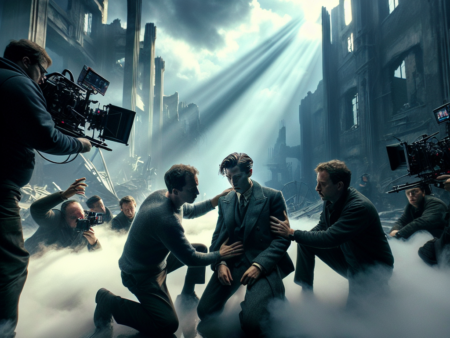Deskripsi meta: Mengungkap peran penting sound design dalam film dan bagaimana suara dapat mempengaruhi pengalaman penonton.
Di Balik Suara: Peran Penting Sound Design dalam Film
-
Table of Contents
- Introduction
- The Evolution of Sound Design in Indonesian Films
- Early Years: Limited Resources, Creative Solutions
- Technological Advancements: Enhancing the Cinematic Experience
- Collaboration with Musicians and Composers
- The Role of Sound Design in Indonesian Films
- Setting the Mood and Atmosphere
- Enhancing Narrative and Storytelling
- Creating Realistic and Immersive Environments
- The Talented Sound Designers of Indonesian Films
- Imam Tantowi
- Kuntari Sutopo
- Khikmawan Santosa
- Conclusion
Introduction

Sound design is an essential element in the filmmaking process that often goes unnoticed by the audience. It is the art of creating and manipulating sounds to enhance the storytelling and emotional impact of a film. In Indonesia, sound design plays a crucial role in the local film industry, contributing to the overall cinematic experience. This article will explore the importance of sound design in Indonesian films, its evolution over the years, and the talented individuals behind it.
The Evolution of Sound Design in Indonesian Films
Early Years: Limited Resources, Creative Solutions
In the early years of Indonesian cinema, sound design was a challenging task due to limited resources and technology. Most films were produced with low budgets, resulting in a lack of sophisticated sound equipment. However, this limitation led to creative solutions, where filmmakers had to rely on their ingenuity to create sound effects. They used everyday objects and improvised techniques to mimic sounds that were not captured during filming.
Technological Advancements: Enhancing the Cinematic Experience
With the advancement of technology, sound design in Indonesian films has significantly improved. The introduction of digital recording and editing tools has allowed filmmakers to have more control over the sound elements in their films. This has led to a more immersive and realistic cinematic experience for the audience.
Collaboration with Musicians and Composers
In recent years, there has been a growing trend of collaboration between sound designers and musicians/composers in Indonesian films. This collaboration has resulted in a seamless integration of sound design and music, creating a harmonious blend that enhances the emotional impact of the film. By working together, sound designers and musicians can create a unique sonic identity for each film, making it more memorable and engaging for the audience.
The Role of Sound Design in Indonesian Films
Setting the Mood and Atmosphere
Sound design plays a crucial role in setting the mood and atmosphere of a film. Through the careful selection and manipulation of sound elements such as background noise, ambient sounds, and music, sound designers can create a specific emotional tone for each scene. For example, a horror film may use eerie sound effects and dissonant music to create a sense of tension and fear, while a romantic film may use soft, melodic music to evoke feelings of love and intimacy.
Enhancing Narrative and Storytelling
Sound design is also instrumental in enhancing the narrative and storytelling of a film. It can provide important cues and information to the audience, guiding them through the story. For example, the sound of footsteps approaching can build suspense and anticipation, while the sound of a door closing can signify the end of a scene or the beginning of a new one. Sound designers carefully craft these auditory cues to ensure that the audience remains engaged and connected to the story.
Creating Realistic and Immersive Environments
One of the primary goals of sound design is to create realistic and immersive environments for the audience. By carefully selecting and layering sound effects, sound designers can transport the audience to different locations and time periods. For example, the sound of bustling city streets, chirping birds, or crashing waves can make the audience feel like they are part of the film’s world. This attention to detail adds depth and richness to the overall cinematic experience.
The Talented Sound Designers of Indonesian Films
Imam Tantowi
Imam Tantowi is one of the most renowned sound designers in Indonesia. With over 20 years of experience in the industry, he has worked on numerous critically acclaimed films. His attention to detail and ability to create unique soundscapes have made him a sought-after collaborator for many Indonesian filmmakers. Some of his notable works include “The Raid” and “The Night Comes for Us,” where his sound design played a crucial role in enhancing the action sequences and intensifying the overall cinematic experience.
Kuntari Sutopo
Kuntari Sutopo is another talented sound designer who has made significant contributions to the Indonesian film industry. Her work on films like “The Mirror Never Lies” and “The Seen and Unseen” has garnered critical acclaim. Kuntari’s ability to create subtle and nuanced soundscapes has made her a respected figure in the industry. She believes that sound design is not just about creating realistic sounds but also about evoking emotions and enhancing the storytelling process.
Khikmawan Santosa
Khikmawan Santosa is a sound designer and composer who has worked on a wide range of Indonesian films. His work on “The Dancer” and “The Golden Cane Warrior” showcases his versatility and creativity in sound design. Khikmawan believes that sound design is an art form that requires a deep understanding of the film’s narrative and emotional core. He strives to create soundscapes that resonate with the audience and leave a lasting impression.
Conclusion
Sound design is an integral part of the filmmaking process in Indonesia. It has evolved over the years, thanks to technological advancements and the collaboration between sound designers and musicians/composers. Sound design plays a crucial role in setting the mood, enhancing storytelling, and creating realistic environments in Indonesian films. The talented sound designers in the country, such as Imam Tantowi, Kuntari Sutopo, and Khikmawan Santosa, have made significant contributions to the industry. Their work showcases the importance of sound design in creating a compelling and immersive cinematic experience. As audiences continue to appreciate the art of sound design, it is essential to recognize and celebrate the talented individuals behind the scenes who bring films to life through their sonic creations.






